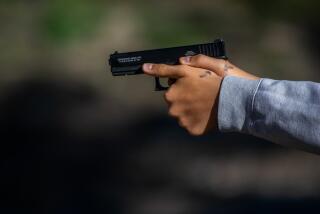CONVERSATION / CAROL ANN TAYLOR : ‘Look at That Gang Member Like He Was Your Child’
In March, 1993, Willie Brooks IV, 17, was shot and killed while talking to a teen - age girl on a sidewalk near Vermont Avenue and Imperial Highway. His mother, CAROL ANN TAYLOR, volunteers much of her time with Women Against Gun Violence in hopes of sparing other families the anguish she felt when her only child was killed. Taylor spoke with KAY MILLS at the Mid-City home to which she moved after her son’s death.
Mills is the author of “From Pocahontas to Power Suits: Everything You Need to Know About Women’s History in America,” (Plume, 1995) and currently an Alicia Patterson Journalism Fellow.
Question: Please tell me about the day Willie got killed.
Answer: I was getting ready for bed when a knock came on the door. The knock was like an earthquake. Something had happened to Willie. When I finally saw him (at the hospital), his eyes were half open and he had his hands in a prayer position. I just screamed and hollered, “I’m sorry. I’m sorry. I’m sorry.” I was supposed to be able to protect him.
The police wanted to say that Willie was a gang member but I knew differently. I do know Willie was a wanna-be when he was 12 or 13, imitating someone else’s behavior. With the terror these kids are going through, I don’t know who he may have aligned himself with to feel safe. He told me peer pressure couldn’t get him. But even if he was a gang member, I wouldn’t be angry with him. I would be trying to help. Parents can’t look the other way.
Q: You visit young people at the California Youth Authority. What do they say about why they committed their crimes?
A: One young man said his nephew had been murdered by the same boys that he played basketball and Little League baseball with. He said, “Carol, they dumped an AK-47 load of 17 bullets into my little 8-year-old nephew. What could he have done to them?” This young man’s father was in and out of prison and his mother was a drug addict. Violence was acceptable in his home and in his community. He was born into it and he had no different kind of role models. Another kid (told me about the murder he committed). He said: “It was a task that I had to complete. This was part of my job as a member of this gang.”
I asked him, “If you had a group of your friends that were playing basketball or Ping-Pong and then you had another group that were gang members, what group would you have chosen?” He said, “Of course, I’d shoot the ball. We didn’t have a group like that.”
Q: So there are not enough positive programs?
A: Positive programs, positive male role models, positive friends. If you want to be good and all of your friends are doing these violations and this is acceptable behavior--if doing something different makes you a sissy or a pushover, you won’t do it. Everybody wants to fit in.
Q: What can parents do?
A: Be receptive to all the children. Until you can look at a pregnant 14-year-old like she was your daughter or that gang member like he was your child, it’s not going to stop.
Of course, there are too many guns. That’s part of the problem. But if we get rid of all the guns and people’s thinking doesn’t change, they’ll use bare hands.
After Willie passed, I talked to everybody who knew my son. His teacher said, “Did you know that when he was boxing groceries, there were kids coming in and putting guns on him?” You know how that makes me feel as a mother, not knowing what my son was going through? I could see the body language. I knew something was wrong and he wouldn’t tell me he was scared to death. That wasn’t one day, that wasn’t a week, that was from the time he was 14 and I didn’t even know. I was trying to parent like Ozzie and Harriet did. The environment has changed.
We are the ones in a position to change that environment. As a community, when the first black child’s head hit (the pavement), we should have been up in arms.
Q: What is Women Against Gun Violence doing?
A: We send a sympathy letter to survivors of shooting victims, saying (the person’s) life was not in vain and that there are organizations, we being one of them, trying to make a difference on the proliferation of guns and the allowing of perpetrators to run free. It offers them some solace so they won’t think (they’re alone) like I thought I was. I was in a rage. But through Women Against Gun Violence, I was able to channel it the proper way.
We let the (appropriate legislators) know that these people lost their lives and that we are watching their votes. I’ve spoken at Venice High School and Manual Arts, and to parents as part of the community outreach program of the California Youth Authority.
There is no one aspect of this that we can deal with effectively to eliminate this problem unless everything is worked on together. We can get rid of all the gangs. But if a boy’s mother is still being beat up by that man in that house, you’ve still got a kid in a rage that’s going to get somebody.
Q: What do you say to parents who know something’s wrong but don’t know what?
A: Get the children to somebody that they will open up and talk to, no matter how bad it is. One of the guys at Venice High School said, “Why talk to your parents? They’re not going to listen.” I said, “Do me a favor. Your mother loves you just like she did when you scraped your knee when you were 6. Write her a note and leave it on the dresser.”
Sometimes the parents are scared but they need to know. We’re talking about lives. There’s nothing more important.
More to Read
Sign up for Essential California
The most important California stories and recommendations in your inbox every morning.
You may occasionally receive promotional content from the Los Angeles Times.










